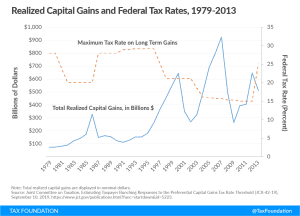
Blog Articles


Booker’s Plan to Eliminate Step-up in Basis and Expand the Estate Tax
Removing step-up in basis would encourage taxpayers to realize capital gains and it would plug a hole in the current income tax, while increasing federal revenue. Combined, however, with the estate tax, this would result in a significant tax burden on certain saving by requiring both the appreciation in and total value of transferred property to be taxed at death
2 min read
Senator Sanders Proposes a Tax on “Extreme” Wealth
Bernie Sanders recently became the second major Democratic presidential candidate to propose a wealth tax.
2 min read
JCT Report Shows Capital Gains are Sensitive to Taxation
JCT’s report on capital gains elasticities reminds us that capital gains realizations, at least under a tax system that allows deferral, are sensitive to tax rates. Moving to mark-to-market taxation of all capital gains would remove this sensitivity by taxing capital gains annually.
4 min read

Senator Bennet’s Plan to Expand the EITC
3 min read
OECD Tackling Harmful Tax Practices
Countries around the world often design their tax policies to become attractive targets for foreign investment. These policies can be anything from a system with special preferences for certain industries to a well-designed tax system based on principles of sound tax policy. Systems that are rife with special preferences and complexities can create distortions in local jurisdictions and across the global economy.
3 min read
No Good Options as Chicago Seeks Revenue
Facing an $838 million budget shortfall, a looming pension crisis, and an aggressive spending wish list, some Chicago policymakers and activists are expressing interest in a laundry list of new and higher taxes that could, collectively, raise as much as an additional $4.5 billion a year.
6 min read

Evaluating Senator Wyden’s “Mark-to-Market” Capital Gains Tax
Wyden’s “mark-to-market” proposal strives to subject capital gains to the same treatment as ordinary income. While the plan resolves the “lock in effect” issue and would make the tax code more progressive, it would increase the tax burden on savers and increase tax code complexity.
2 min read
Standard VAT Rate on German Meat?
2 min read


New Evidence on the Benefits of Full Expensing
Additional evidence on the economic benefits of full expensing of investment was recently published in the American Economic Journal: Economic Policy.
4 min read

Amazon Passes France’s Digital Services Tax on to Vendors
France’s new 3 percent digital tax may be targeted at Amazon and other large digital firms, but Amazon’s French vendors will bear the burden of the tax.
3 min read


